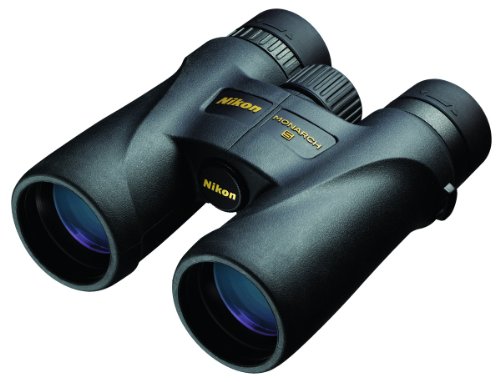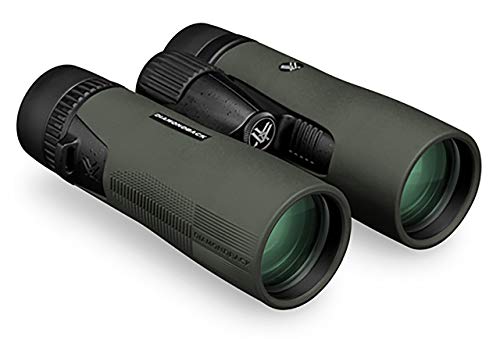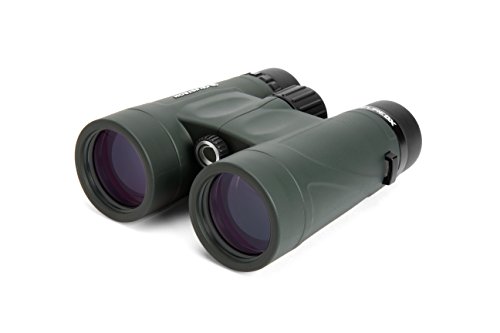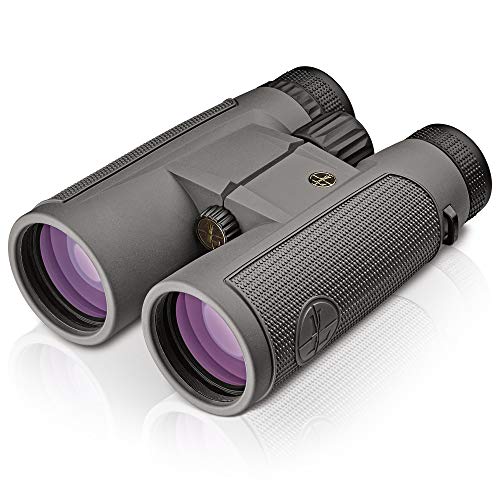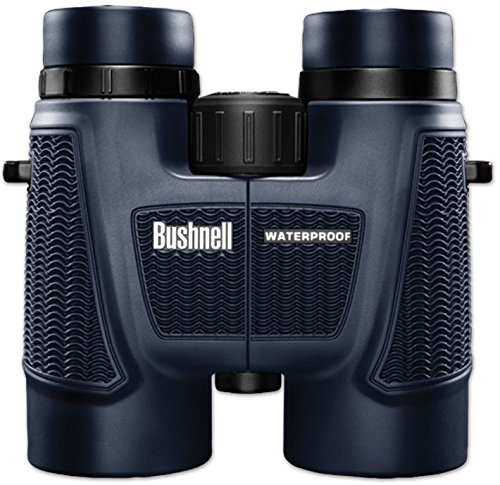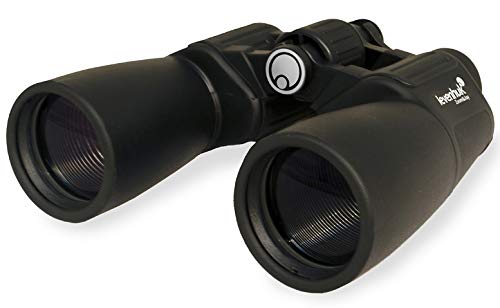8 Best Binoculars for Safari of 2025 – Reviews & Buyer’s Guide
Last Updated on
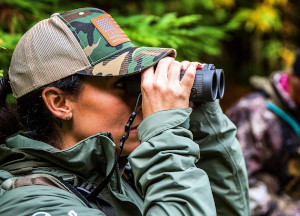
When you’re on safari, the right binoculars will let you see distant animals with remarkable clarity, while the wrong pair will leave them fuzzy or invisible. Online shopping should make it easier to find the right binoculars for your expedition. In practice, the number of choices and misleading product descriptions can make it tricky to get what you need.
We want you to get the equipment you need for a great safari experience. We’ve collected some reviews of our favorite binoculars in this list, where we explain why they’re great choices. We’ve also included a buyer’s guide about everything you need to know to make a great decision, even if you’ve never used binoculars before.

A Quick Look at the Winners of 2025:
| Image | Product | Details | ||
|---|---|---|---|---|
| Best Overall |
 |
Nikon MONARCH 5 |
|
CHECK PRICE |
 |
Vortex Diamondback 8×42 |
|
CHECK PRICE | |
| Best Value |
 |
Celestron Nature 8×42 |
|
CHECK PRICE |
 |
Avalon 10×42 |
|
CHECK PRICE | |
 |
Leupold BX-1 McKenzie |
|
CHECK PRICE |
The 8 Best Safari Binoculars:
1. Nikon MONARCH 5 Binocular – Best Overall
If you’re going on a safari, you need binoculars that will give you excellent views, while also being hardy enough to stand up to the elements. The Nikon 7576 MONARCH 5 8×42 Binocular was redesigned to be an ounce lighter than the previous version. That doesn’t sound like a lot, but it can make a big difference on an all-day excursion. The rugged armor will protect it from most dings and even some drops, which makes it a good choice for a safari. It’s also waterproof and fog proof, so the internal optics should remain clear, even in inclement weather.
It features Nikon’s great ED glass, which stands for “extra-low dispersion.” This means you’ll get superior image quality with less chromatic aberration and sharper long-range images. It’s also user-friendly, as it comes with adjustable eyecups and a simple center-focusing wheel. While it’s not great for up-close viewing, with a minimum focusing distance of eight feet, it will perform spectacularly at the long ranges you experience on safaris. This is a great pair of binoculars, with the ruggedness and quality needed for serious outdoor excursions.
All in all, we think that these are the best binoculars for safari trips.
- Lightweight
- ED glass
- Easy to use
- Waterproof and fog proof
- Long close-focus range
2. Vortex Diamondback 8×42 Safari Binoculars
The Vortex Optics Diamondback 8×42 Binoculars are another good choice for safari use. They’re fogproof and waterproof, so you shouldn’t have to worry about their optics fogging up. They also come with a short-hinge design that frees up more of the barrel for your hands. That makes them comfortable to hold, and harder to drop than other binoculars of similar weight and size. The adjustable eyepieces make this model a good choice for those with glasses, as you’ll be able to adjust them to work with or without your glasses.
These binoculars are focused via a center wheel. The right eyepiece is also independently adjustable, so you can get a custom fit if you have different vision in each eye. The cheap lens caps keep this model out of first place. They often fall off, so it can be hard to keep up with them, and they don’t do their job of protecting the lenses. With better lens caps, there’s a chance this set could rise to first place. Still, if you don’t like the Nikon set on top of this list, this is a great alternative.
- Fogproof and waterproof
- Short-hinge design
- Adjustable eyepieces
- Independent focusing
- Cheap lens caps
3. Celestron Nature 8×42 Binoculars – Best Value
The Celestron 71332 Nature DX 8×42 Binocular may seem priced in a way that’s too good to be true, but in this case, it may be just as good as you’d hope. This pair is waterproof, making it great for safaris and other outdoor activities. It also has some of the best eye relief of any binoculars on the market, providing a remarkable 18 millimeters of distance between the lens and the focused image. That makes it great for glasses users or those who don’t like holding the binoculars against their faces all day.
These binoculars come with phase-coated BaK-4 prisms, which provide excellent clarity without driving the price up. Speaking of price, this model will set you back about half of what the top two sets on our list cost. Since there’s no appreciable drop-off in quality, you can get a great experience at a fraction of the typical cost, making these the best overall value. The only issue is that they’re about 50 percent heavier than our top models. Still, if you want a great viewing experience for a low price, you can’t beat these binoculars.
- Waterproof
- Excellent eye relief
- Great clarity
- Incredible price
- Heavy
4. Avalon 10×42 Safari Binoculars
The Avalon 10×42 PRO HD Binoculars are extremely lightweight, weighing just under one and a quarter pounds. That makes them excellent for all-day use, and they won’t put too much strain on your neck. This pair also comes with higher magnification than others here. You’ll get more detail at longer distances, but your field of view will be smaller, so there’s a real tradeoff there. These come with adjustable eyepieces, which makes them useful for people who use glasses, or who will otherwise adjust the eye relief throughout the day.
These binoculars are waterproof and fogproof, so they’re ready for whatever weather conditions may come along. You won’t have to worry about humidity or a chance rainstorm ruining them. Unfortunately, these binoculars have a poor close focus distance of nearly ten feet. That may not be a dealbreaker on a safari where most of your viewing will be medium- to far-distance, but these don’t work as well at close range. These binoculars are good, but there are some superior options out there.
- Very lightweight
- High magnification
- Adjustable eyepieces
- Waterproof and fog proof
- Poor close focus
5. Leupold BX-1 McKenzie Binoculars for Safari
The Leupold BX-1 McKenzie Binocular does many things right. This set is waterproof, so you’ll be able to use it in all weather conditions. If you’re looking for binoculars with greater magnification, you’ll like these, since they come with 10x magnification. Again, there’s a tradeoff between magnification and field of view, but if you want to make out more detail at longer distances, these will be up to the task. They’re well-built and very sturdy, so they should easily survive heavy bumps or the occasional accidental drop.
However, they’re pretty heavy for binoculars, as they weigh more than two pounds. You can find sets that weigh roughly half that, and if you’re going to be wearing them around your neck all day, they can get tiresome. They also have some chromatic aberration. Consequently, images won’t be as sharp as those from competing models. If you’re going on a safari, you’ll want crystal-clear images, and this model can’t consistently give you those. It’s a decent pair of binoculars, but there are plenty of others that offer better value for the money.
- Waterproof
- Good magnification
- Sturdy
- Chromatic aberration
- Heavy
6. Bushnell H2O Roof Prism Binoculars
Sometimes a product’s build quality is fine, but it has design mistakes that make it unpleasant to use. Unfortunately, the Bushnell H2O 10 x 42 Waterproof Roof Prism Binocular is one of those products. To its credit, it’s waterproof and nitrogen-filled. That means it shouldn’t fog up internally, and that it’s safe to use in outdoor activities. It also weighs just a pound and a half. That’s not the lightest on our list, but it’s excellent for a model with 10x magnification. If you’re looking for a set with a bit more magnification, you may potentially like this one.
However, it isn’t easy to focus. The eyepieces sometimes get out of sync, and that can make it hard to get the quick focusing you need to see fleeting animals. It also gets lots of glare on sunny days, which means the best days for safaris are the worst days for this set. That’s a serious problem that you can’t fix easily on your own. Ultimately, this won’t be the right pair of binoculars for most people going on a safari.
- Waterproof and nitrogen-filled
- Good magnification
- Lightweight
- Struggles on bright days
- Tricky focusing
7. Gosky 10×42 Safari Binoculars
You may think you need an expensive camera and an even more expensive zoom lens to take great pictures on your safari. However, the Gosky 10×42 Roof Prism Binoculars can serve as a zoom lens for your smartphone’s camera, allowing you to get pictures that are just as good for a fraction of the price. These binoculars include a smartphone mount, which works with most modern smartphones, and allows you to take excellent photos at a distance. You can also use the smartphone as a viewing device, so you don’t have to hold your eyes to the eyepieces. Even with that extra part included, these aren’t very expensive binoculars.
However, they’re far clearer in the center than they are around the edges. This can do weird things to the resulting images. Even if you’re just using them for viewing, you may dislike the way the image is distorted. With the mount included, these binoculars feel heavy, and you may not like holding them up all day. Overall, they’re good for people who have smartphones and want to use them, but otherwise, you’ll be happier with a different pair of binoculars.
- Inexpensive
- Smartphone mount
- Clear in the center
- Blurry around edges
- Heavy
8. Levenhuk 7×50 Porro Prism Binocular
The Levenhuk Sherman 7×50 Classic Porro Prism Binoculars have a conflicting set of optics and fail to live up to expectations in other areas. They’re nitrogen-filled, which is something you don’t always find at this price point. That gas fill means you shouldn’t have to worry about the internal optics fogging up. This model does come with 50-millimeter lenses, which allow more light gathering, and ultimately clearer and sharper images. However, it squanders some of that with its inferior magnification at just 7x. That makes it weaker than any other binoculars on our list, and in some circumstances, it won’t have the magnification you need to fully enjoy your safari.
The neck strap is also uncomfortable. That’s not a problem you’ll want to be dealing with throughout the day. You could just hold it, but this model is far heavier than others on this list, so that’s not something you’ll want to do either. If you’re looking for inexpensive binoculars, these pass that test, but the serious flaws mean most people won’t enjoy using them.
- Large lenses
- Nitrogen-filled
- Poor magnification
- Uncomfortable neck strap
- Extremely heavy

Buyer’s Guide – Picking the Best Binoculars for Safari
Magnification and lens size
Two of the most important things to understand about binoculars are magnification and lens size. You’ll frequently see a number like “8×42” listed with a product’s name. The “8” refers to the magnification, so these binoculars will make things appear eight times closer.
The “42” refers to the lens size in millimeters. The bigger the number is, the larger the lens is. The larger the lens is, the more light gets in, and more light means a brighter and clearer image.
As magnification increases, the field of view, or the area visible in the image, gets smaller. You also have to hold binoculars with greater magnification more carefully, as small movements can lead to the image becoming very unstable.
Waterproof
It’s extremely important to invest in waterproof binoculars. There’s always the chance of getting caught in the rain, spilling water, or even getting sweat inside your binoculars. Moisture likes to settle on the mirrors and lenses in binoculars, which renders them unusable.
To help avoid this problem, look for waterproof and fogproof sets. Fogproof models are also resistant to humidity, which makes them even less likely to get fogged up. It’s also a good idea to get binoculars with a nitrogen or argon fill, as these are purged of humidity that could potentially cause problems.
Visual clarity
To get the most out of your binoculars, you’ll want to maximize the visual clarity you get from the image. After all, if you can’t make out good detail, you’re not going to enjoy your safari.
ED glass, or extra-low dispersion glass, is a material used for binocular and telescope lenses that corrects for natural refraction of light. This leads to a sharper final image and reduces the chances of chromatic aberration, which is the spreading of colors of different wavelengths. You can typically only find ED glass in high-end binoculars, but it’s often well worth the price.
Other Binocular Posts You May Find Interesting:
- Our tips & tricks to holding your binoculars steady
- Our in-depth reviews of 8×32 binoculars
- Vortex Crossfire vs Diamondback Binoculars: Which is Best?

Conclusion:
The Nikon 7576 MONARCH 5 8×42 Binocular is our favorite model due to the lightweight, ED glass, and easy use. In second is the Vortex Optics Diamondback 8×42 Binoculars. They’re fog proof and waterproof, feature a great short-hinge design, and have adjustable eyepieces. Their cheap lens caps keep them out of the top spot. Third place belongs to the Celestron 71332 Nature DX 8×42 Binocular, which is waterproof and provides excellent eye relief and clarity. Since it’s sold for half the price of the top two choices, it’s the best value for the money here. When it comes to the best binoculars for safari, you can’t go wrong with any of the above.
The Avalon 10×42 PRO HD Binoculars are very lightweight, provide high magnification, and have adjustable eyepieces, but their poor close focus hurts their value. In fifth place, the Leupold BX-1 McKenzie Binocular is waterproof and has good magnification, but suffers from chromatic aberration and a heavy frame. The Bushnell H2O 10×42 Waterproof Roof Prism Binocular takes sixth place with its waterproof and nitrogen-filled frame and good magnification. However, it struggles on bright days and is tricky to focus.
The Gosky 10×42 Roof Prism Binoculars land in seventh place with their low price and inclusion of a smartphone mount, though they weigh a lot and don’t provide the clarity that non-smartphone users will value. In the last place is the Levenhuk Sherman 7×50 Classic Porro Prism Binoculars. They have large lenses but lose a lot of value because of their poor magnification, heavyweight, and uncomfortable neck strap.
We hope our reviews and buyer’s guide have helped you see which pair of binoculars are best for you, and you can now find a set that performs at a great price.
Good luck finding the best safari binoculars for your needs!
Also, we often get asked which binoculars are best for Yellowstone National Park. See our recommendation here.
Table of Contents
- A Quick Look at the Winners of 2025:
- The 8 Best Safari Binoculars:
- 1. Nikon MONARCH 5 Binocular – Best Overall
- 2. Vortex Diamondback 8×42 Safari Binoculars
- 3. Celestron Nature 8×42 Binoculars – Best Value
- 4. Avalon 10×42 Safari Binoculars
- 5. Leupold BX-1 McKenzie Binoculars for Safari
- 6. Bushnell H2O Roof Prism Binoculars
- 7. Gosky 10×42 Safari Binoculars
- 8. Levenhuk 7×50 Porro Prism Binocular
- Buyer’s Guide – Picking the Best Binoculars for Safari
- Conclusion:
About the Author Robert Sparks
Robert’s obsession with all things optical started early in life, when his optician father would bring home prototypes for Robert to play with. Nowadays, Robert is dedicated to helping others find the right optics for their needs. His hobbies include astronomy, astrophysics, and model building. Originally from Newark, NJ, he resides in Santa Fe, New Mexico, where the nighttime skies are filled with glittering stars.
Related Articles:
When Were Binoculars Invented? History, Today & Future
How to Clean a Refractor Telescope: Step-by-Step Guide
How to Clean a Telescope Eyepiece: Step-by-Step Guide
How to Clean a Rifle Scope: 8 Expert Tips
Monocular vs Telescope: Differences Explained (With Pictures)
What Is a Monocular Used For? 8 Common Functions
How to Clean a Telescope Mirror: 8 Expert Tips
Brightfield vs Phase Contrast Microscopy: The Differences Explained




